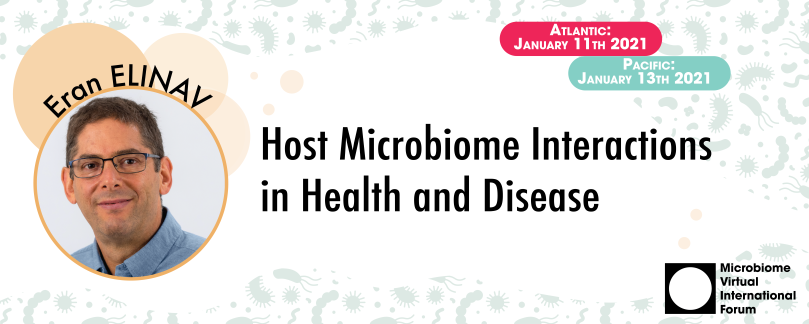Bio
Prof. Eran Elinav, M.D., Ph.D. is a professor at the Department of Immunology, Weizmann Institute of Science, and since 2019 the director of the cancer-microbiome division, at the Deutsches Krebsforschungszentrum (DKFZ), Heidelberg, Germany. His labs at the Weizmann Institute and DKFZ focus on deciphering the molecular basis of host-microbiome interactions and their effects on health and disease, with a goal of personalizing medicine and nutrition. Dr. Elinav completed his medical doctor’s (MD) degree at the Hebrew University of Jerusalem Hadassah Medical Center summa cum laude, followed by a clinical internship, residency in internal medicine, and a physician-scientist position at the Tel Aviv Medical Center Gastroenterology institute. He received a PhD in immunology from the Weizmann Institute of Science, followed by a postdoctoral fellowship at Yale University School of Medicine. Dr. Elinav has published more than 150 publications in leading peer-reviewed journals, including major recent discoveries related to the effects of host genetics, innate immune function and environmental factors, such as dietary composition and timing, on the intestinal microbiome and its propensity to drive multi-factorial disease. His honors include multiple awards for academic excellence including the Claire and Emmanuel G. Rosenblatt award from the American Physicians for Medicine (2011), the Alon Foundation award (2012), the Rappaport prize for biomedical research (2015) the Levinson award for basic science research (2016), and the Landau prize (2018). Since 2016 he is a senior fellow at the Canadian Institute For Advanced Research (CIFAR), since 2017 he is an elected member, European Molecular Biology Organization (EMBO) and an international scholar at the Howard Hughes Medical Institute (HHMI) and the Bill & Melinda Gates Foundation.
Prof. Jotham Suez will answer questions during the Pacific event on January 13th.
SELECTED TALKS
Protective effects of the gut microbial metabolite TMAO upon the brain - there is no such thing as a 'good' or 'bad' metabolite
Although our understanding of the importance of the gut microbiota-brain axis in health and disease has increased dramatically over the last decade, our knowledge of the signalling systems that underlie this communication lags behind. Strong evidence points to a role for the various microbial metabolites found in the host circulation and their actions at the principal interface of the brain and the periphery, the blood-brain barrier (BBB). Trimethylamine N-oxide (TMAO) is produced by hepatic oxidation of its gut microbe-derived precursor trimethylamine (TMA) and has been associated with a number of cardiovascular disorders in population-level studies, although its effect(s) on the brain have received less attention. We investigated whether TMAO could modulate the cerebral vasculature and what implications this might have for cognition. We show that physiologically relevant concentrations of TMAO enhance and protect BBB integrity in vitro, acting by mobilisation of the inter-endothelial tight junction regulator annexin A1, while in contrast, TMA impaired BBB function and disrupted tight junction integrity. Notably, beneficial effects of TMAO were replicated in vivo, with its administration reversing BBB impairment induced by either acute or chronic administration of lipopolysaccharide (LPS). This protective effect was consequential for brain function, with long-term TMAO administration via the drinking water preventing LPS-induced recognition memory impairment. Further examination revealed that TMAO prevented LPS-induced glial activation in the entorhinal cortex, a key area for recognition memory. Together, these data identify TMAO as a significant actor in the gut-brain axis, and indicate beneficial effects upon both the brain’s defensive systems and cognitive function – emphasising the importance of dose in studying microbial metabolites. This broadens the range of mediators involved in gut microbe-brain communication, and reinforces the BBB as a significant interface in this axis. As circulating TMAO is ultimately derived from dietary choline, these changes may help explain the well-known beneficial effects of consumption of a seafood-rich diet upon the brain and could have implications for neurological conditions such as dementia.
Simon McArthur
Institute of Dentistry, Faculty of Medicine, Queen Mary, University of London
Microbial enrichment and storage for metagenomics of vaginal, skin, and saliva samples
Few validated protocols are available for large-scale collection, storage, and analysis of microbiome samples from the vagina, skin, and mouth. To prepare for a large-scale study on the female microbiome by remote self-sampling, we investigated the impact of sample collection, storage, and host DNA depletion on microbiome profiling. Vaginal, skin, and saliva samples were analyzed using 16S rRNA gene amplicon and metagenomic shotgun sequencing, and qPCR. Of the two tested storage buffers, the eNAT buffer could keep the microbial composition stable during various conditions. All three tested host DNA-depletion approaches showed a bias against Gram-negative taxa. However, using the Host- ZERO Microbial DNA and QIAamp DNA Microbiome kits, samples still clustered according to body site and not by depletion approach. Therefore, our study showed the effectiveness of these methods in depleting host DNA. Yet, a suitable approach is recommended for each habitat studied based on microbial composition.
Sarah Ahannach and Lize Delanghe
Department of Bioscience Engineering, Research Group Environmental Ecology and Applied Microbiology, University of Antwerp
HIGHLIGHTS
Variation and transmission of the human gut microbiota across multiple familial generations
Although the composition and functional potential of the human gut microbiota evolve over the lifespan, kinship has been identified as a key covariate of microbial community diversification. However, to date, sharing of microbiota features within families has mostly been assessed between parents and their direct offspring. Here we investigate the potential transmission and persistence of familial microbiome patterns and microbial genotypes in a family cohort (n = 102) spanning 3 to 5 generations over the same female bloodline. We observe microbiome community composition associated with kinship, with seven low abundant genera displaying familial distribution patterns. While kinship and current cohabitation emerge as closely entangled variables, our explorative analyses of microbial genotype distribution and transmission estimates point at the latter as a key covariate of strain dissemination. Highest potential transmission rates are estimated between sisters and mother–daughter pairs, decreasing with increasing daughter’s age and being higher among cohabiting pairs than those living apart. Although rare, we detect potential transmission events spanning three and four generations, primarily involving species of the genera Alistipes and Bacteroides. Overall, while our analyses confirm the existence of family-bound microbiome community profiles, transmission or co-acquisition of bacterial strains appears to be strongly linked to cohabitation. Link to the OA paper: https://www.nature.com/articles/s41564-021-01021-8
Mireia Valles-Colomer
CIBIO – University of Trento
Reporting guidelines for human microbiome research: the STORMS checklist
The particularly interdisciplinary nature of human microbiome research makes the organization and reporting of results spanning epidemiology, biology, bioinformatics, translational medicine and statistics a challenge. Commonly used reporting guidelines for observational or genetic epidemiology studies lack key features specific to microbiome studies. Therefore, a multidisciplinary group of microbiome epidemiology researchers adapted guidelines for observational and genetic studies to culture-independent human microbiome studies, and also developed new reporting elements for laboratory, bioinformatics and statistical analyses tailored to microbiome studies. The resulting tool, called ‘Strengthening The Organization and Reporting of Microbiome Studies’ (STORMS), is composed of a 17-item checklist organized into six sections that correspond to the typical sections of a scientific publication, presented as an editable table for inclusion in supplementary materials. The STORMS checklist provides guidance for concise and complete reporting of microbiome studies that will facilitate manuscript preparation, peer review, and reader comprehension of publications and comparative analysis of published results. Link to OA paper: https://www.nature.com/articles/s41591-021-01552-x
Chloe Mirzayi
CUNY Graduate School of Public Health and Health Policy, Institute for Implementation Science in Public Health
A mouse model of occult intestinal colonization demonstrating antibiotic-induced outgrowth of carbapenem-resistant Enterobacteriaceae
Background: The human intestinal microbiome is a complex community that contributes to host health and disease. In addition to normal microbiota, pathogens like carbapenem-resistant Enterobacteriaceae may be asymptomatically present. When these bacteria are present at very low levels, they are often undetectable in hospital surveillance cultures, known as occult or subclinical colonization. Through the use of antibiotics, these subclinical pathogens can increase to sufficiently high levels to become detectable, in a process called outgrowth. However, little is known about the interaction between gut microbiota and Enterobacteriaceae during occult colonization and outgrowth. Results: We developed a clinically-relevant mouse model for studying occult colonization. Conventional wild-type mice without antibiotic pre-treatment were exposed to K. pneumoniae but rapidly tested negative for colonization. This occult colonization was found to perturb the microbiome as detected by both 16S rRNA amplicon and shotgun metagenomic sequencing. Outgrowth of occult K. pneumoniae was induced either by a four-antibiotic cocktail or by individual receipt of ampicillin, vancomycin or azithromycin, which all reduced overall microbial diversity. Notably, vancomycin was shown to trigger K. pneumoniae outgrowth in only a subset of exposed animals (outgrowth-susceptible). To identify factors that underlie outgrowth susceptibility, we analyzed microbiome-encoded gene functions and were able to classify outgrowth-susceptible microbiomes using pathways associated with mRNA stability. Lastly, an evolutionary approach illuminated the importance of xylose metabolism in K. pneumoniae colonization, supporting xylose abundance as a second susceptibility indicator. We showed that our model is generalizable to other pathogens, including carbapenem-resistant Escherichia coli and Enterobacter cloacae. Conclusions: Our modeling of occult colonization and outgrowth could help the development of strategies to mitigate the risk of subsequent infection and transmission in medical facilities and the wider community. This study suggests that microbiota mRNA and small-molecule metabolites may be used to predict outgrowth-susceptibility. Link to OA paper: https://www.biorxiv.org/content/10.1101/2021.02.24.432587v1
Choon Kiat Sim
National Human Genome Research Institute (NHGRI), National Institutes of Health (NIH)
Strong oral plaque microbiome signatures for dental implant diseases identified by strain-resolution metagenomics
Dental implants are installed in an increasing number of patients. Mucositis and peri-implantitis are common microbial-biofilm-associated diseases affecting the tissues that surround the dental implant and are a major medical and socioeconomic burden. By metagenomic sequencing of the plaque microbiome in different peri-implant health and disease conditions (113 samples from 72 individuals), we found microbial signatures for peri-implantitis and mucositis and defined the peri-implantitis-related complex (PiRC) composed by the 7 most discriminative bacteria. The peri-implantitis microbiome is site specific as contralateral healthy sites resembled more the microbiome of healthy implants, while mucositis was specifically enriched for Fusobacterium nucleatum acting as a keystone colonizer. Microbiome-based machine learning showed high diagnostic and prognostic power for peri-implant diseases and strain-level profiling identified a previously uncharacterized subspecies of F. nucleatum to be particularly associated with disease. Altogether, we associated the plaque microbiome with peri-implant diseases and identified microbial signatures of disease severity. Link to the OA paper: https://www.nature.com/articles/s41522-020-00155-7
Paolo Ghensi

